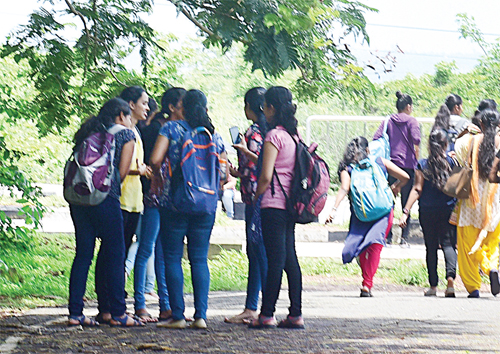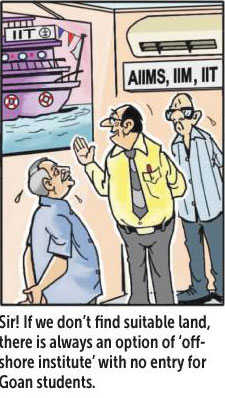24 Jun 2017 | 06:26am IST
20th-64th: Has gu really slipped so much?
Last year, GU was 20th out of 233 institutions in the National Institute of Ranking Framework (NIRF). This year, it is 64th out of 724. Has GU slipped three times? VC Professor Varun Sahani insists that in terms of ratio, it’s a minor drop, but that doesn’t obliterate serious challenges GU faces in holding its place among India’s best. VIBHA VERMA toothcombs the campus to do a comprehensive audit of GU
VIBHA VERMA
Shocked over the dropping in its ranking by National Institute of Ranking Framework (NIRF), Goa University (GU) – that earned good reputation for upgrading its educational system year after year -- has said that “the ranking criteria adopted by the agency was completely in favour of big universities.”
“Soon after the ranking were released, we had ordered an internal inquiry and the report indicated that ranking criteria adopted by the NIRF was completely in favour of big universities like JNU and BHU,” Goa University’s Registrar Y V Reddy told Herald.
State’s lone university had its ranking dropped at 64th position from 20th pressing a panic button amongst the academicians and the State government. The ranking came despite the fact that the university was given top grade by the National Assessment and Accreditation Council (NAAC), three years back, further hiking its standard across the country.
The inquiry committee, Reddy revealed, sent a report to the Ministry of Human Resources Development (MHRD) suggesting to re-look at the criteria since GU is not a central university. “A single/uniform criterion for all universities is not feasible considering various aspects and as such, crossing the Central universities will not be possible. The MHRD Ministry has assured to examine the ranking system,” Registrar Y V Reddy added.
Interestingly, the NIRF ranking was launched during the last academic year itself. The drop indeed came as a shocker for the university, but the concerned authorities who examined the ranking said that increasing number of universities participating in the NIRF process has pushed it downwards. As per them, the GU ranked 20th among 233 universities that applied last year while this year, as many as 724 universities applied for the ranking in which GU was slipped to 64th position.
“It is clear is that in terms of ratios – 20 out of 233 and 64 out of 724 – our ranking should have been not at the 64th position but at the 62nd position. Arithmetically there is a decline of two positions since the last year,” Vice Chancellor Prof Varun Sahani was quoted as saying.
Even during the past ranking wherein 19 universities ranked above GU, about 15 were supported by the Central government at a level much higher than what is available to a state university like GU.
In his statement in the annual report 2015-16 of the Goa University, the then V-C Satish Shetye had said that as more universities participate in the ranking exercise, GU’s standing will come under pressure. “So will our grade as NAAC tightens its processes for assessing of universities. The university has therefore decided to strengthen our practices that pursue excellence
QUALITY CONTROL: Internal Quality assurance Cell set up to monitor quality
The most important in these practices is setting up of the IQAC (Internal Quality Assurance Cell) that monitors quality. The university has a vibrant and visible IQAC set up since last few years. Documentation is the most important activity of the Cell. IQAC now collects an annual self-appraisal report from every member of Goa University faculty. These reports become the source for documenting activities of the university such as this Annual Report, and the Annual Quality Assurance Report submitted to the NAAC.
FUNDS: Additional Rs 50 lakh received, taking total grants to Rs 40 cr, but still short of finances
The main challenge however remains the funds and faculty recruitment. The university has received additional Rs 50 lakh grant compared to the last academic year taking the total grants to Rs 40.1 crore but the institution is still starving for finances. The implementation of Seventh Pay Commission has burdened Goa University by Rs 53 crore annually. Faced with the difficulties, Reddy said they have already communicated to the Goa government which has assured to look into the issue, positively. (See box)
Not opting for Central University status is costing GU Rs 200 crore annually
As a Central university, the GU would have received Rs 200 crore from the Centre on an annual basis but the authorities are in no mood for upgrade GU to the status of a Central university, at least in the coming years. “Opportunities for the Goan students and faculty will be lost, considering that major share of the seats are reserved for them. A marginal amount is left for non-Goan and foreign students, which gets transferred back to Goan candidates, if not filled by the former categories. Once we switch over to Central University, all these facilities will have to be distributed as per their norms,” the Registrar said.
The State-run university that depends on the Goa government for financial grants also uses its internal resources like admission fees for infrastructure and maintenance. Figures revealed that Rs 3.5 crore are collected through these resources whereas the fund received from the state government is spent on the salaries of teaching and non-teaching staff.
Staff shortage a hurdle but filling vacant posts will raise total salary bill to Rs 73 crores annually
The university intends to fill the vacancies starting from December by relaxing certain conditions to tide over the staff shortage. But the recruitment of all faculties will increase the cost on salaries to Rs 73 crore annually (non- teaching staff).
SPACE CRUNCH: A problem in the verge of getting solved
Lack of space to accommodate more seats in some of the popular departments had hindered growth but that is being addressed now, according to GU insiders.
Till a few years ago, the GU could not significantly increase the intake owing to acute space shortage but the problem was resolved with the setting up of two blocks – Science Block-E, and Commerce and Management Studies. The shifting of these two faculties has largely resolved the problem. The new building of UGC Human Resource Development Centre (HRDC) (earlier Academic Staff College) was inaugurated in November 2015. As a result of shifting of the HRDC to the new premises, additional space was available in the library building where the HRDC was earlier housed. This additional space also became available in April 2016 with the inauguration of a new block, Block-F, for the Faculty of Commerce and Management Studies. The Science block on the other hand accommodates four departments of Chemistry, Biotechnology, Microbiology and Zoology.
Conceding that GU indeed has run into some of these problems, Registrar Reddy said, “There is always a scope for improvement.”
One area that needs improvement is the most obvious. The university building itself, as borne out by the former VC Shetye’s report in 2015-16, pointing at the bad architecture of the building. “While the building helped growth of infrastructure available to the university, maintenance of the building is, however, threatening to be a problem. Environmentally-unfriendly architecture, deficient workmanship and poor quality of some of the materials used in construction of the building are likely to lead to a drain on the university’s resources. The university will need to plan for facing this issue,” he had stated.
SOME BRIGHT SPARKS; Choice based credit system, School of Earth, Ocean and Atmospheric Sciences
Nevertheless, the head of department of a faculty told Herald, GU has tried to overcome all the odds. One of its recently achievements is introducing choice based credit system at the undergraduate level. Moreover, the Executive Council recently approved creation of a School of Earth, Ocean and Atmospheric Sciences out of the currently existing departments of Earth and Marine Science.
Prof Sahni, during the recently concluded convocation had spoken about GU’s intentions to recognise traditional master craftsmen and women as instructors and examiners to acknowledge they have very significant skills and knowledge to impart to younger generation.
THE SEEDY SIDE: Suspensions of professors
At the end, GU saw two suspensions of professors, one in a sexual harassment case and another on corruption charges. On February 9, 2017, associate professor Anugraha Mohapatra was suspended following a complaint of alleged sexual harassment made against him by MSc Part I student. In the past, GU dealt with cases of alleged sexual harassment by its employees. A document Goa University Policy (Preventive and Remedial) on Sexual Harassment of Women at the work place 2010 was put into act after the head of a department was dismissed from service in a similar case.
Meanwhile, this year also saw suspension of former Head and Dean of Commerce Faculty Professor B Ramesh following over six years of high level inquiry into financial irregularities.
It’s been a bit of a mixed bag really for Goa University but it is still weighed in problems and there’s a lot of work in progress. 20 to 64 may not mean that GU has slipped by more than three times, but it is indeed a wakeup call.

